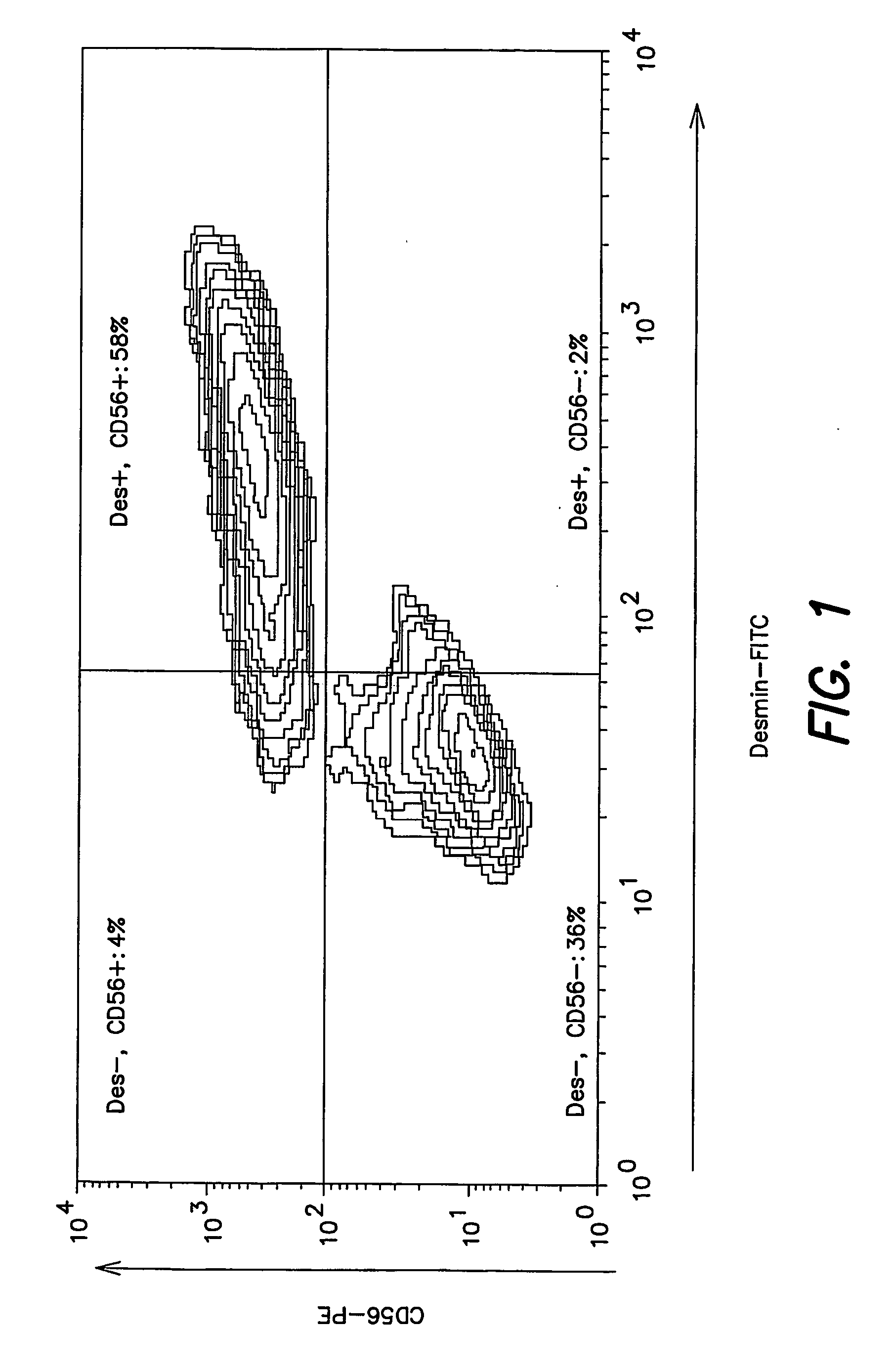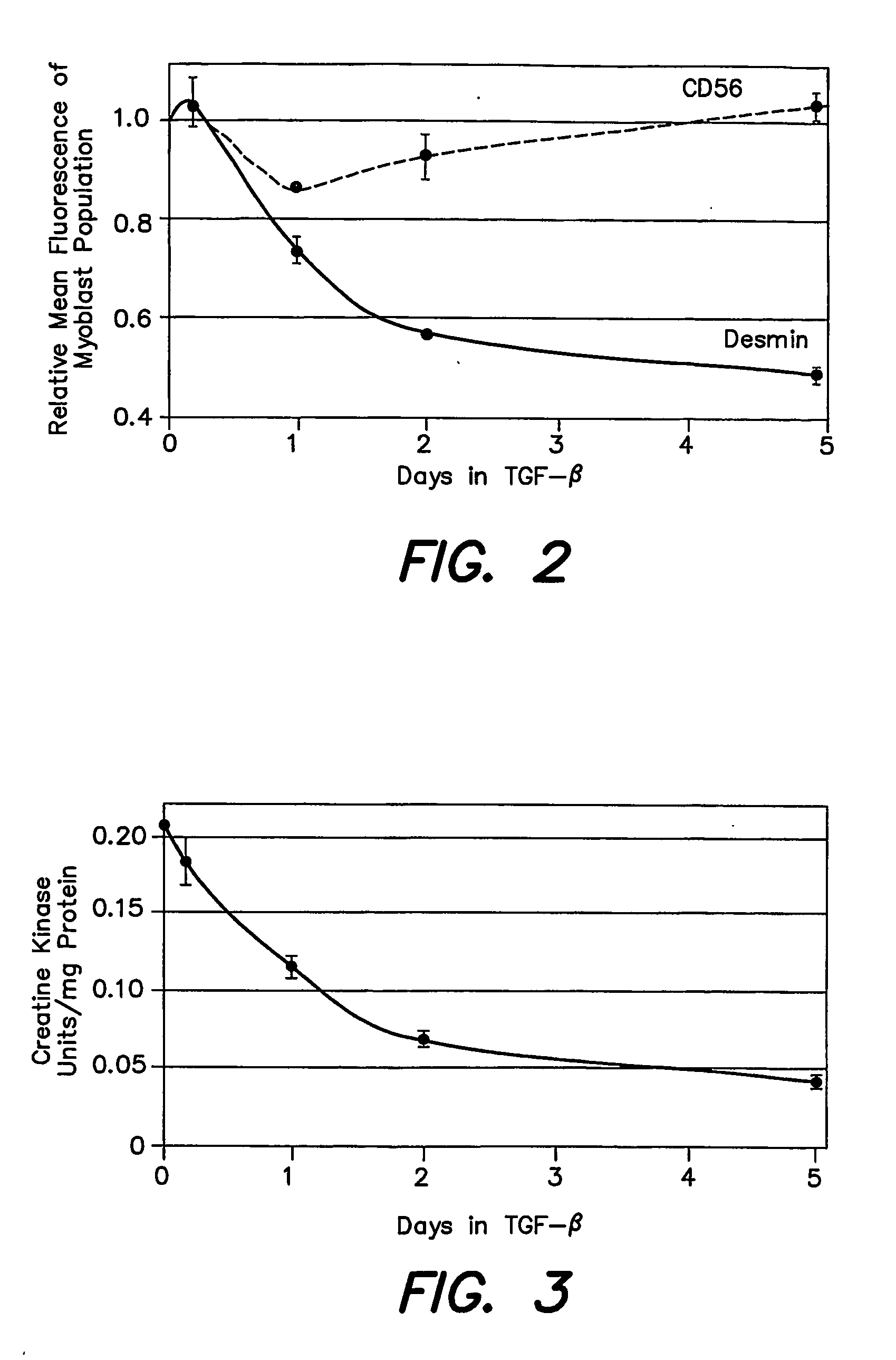Skeletal musle-derived cells and methods related thereto
a technology of skeletal muscle and derived cells, applied in the direction of skeletal/connective tissue cells, biocide, peptide/protein ingredients, etc., can solve the problems of frequent and life-threatening conditions, heart failure, etc., and achieve the effect of reducing desmin expression and reducing desmin expression
- Summary
- Abstract
- Description
- Claims
- Application Information
AI Technical Summary
Benefits of technology
Problems solved by technology
Method used
Image
Examples
example 1
Derivation of HuSkMCs Strains
[0050] HuSkMCs were derived from quadriceps muscle of a 25 year old male cadaver (Strain A), rectus femoris muscle of a 77 year old female amputee (Strain B), quadricep muscle of a 36 year old female cadaver (Strain C), or vastus laterus muscle of a 45 year old male cadaver (Strain D). Cadaver tissue, provided by the National Disease Research Institute (NDRI, Philadelphia, Pa.), was procured 8 to 19 hours post-mortem. Skeletal muscle was shipped and maintained at 0-4° C. for 2-4 days in University of Wisconsin's Solution or Iscove's Modified Dulbecco's Medium (IMDM). Then muscle was trimmed of obvious connective tissue and fat and rinsed in phosphate buffered saline (PBS). The trimmed muscle, with a wet weight of at least 4 grams, was minced into pieces of approximately 1 mm3. The minced muscle was digested in type II Collagenase (Worthington, Lakewood, N.J.) at 470 U / ml, using 15-30 ml digestion solution per gram muscle, at 37° C. for 1 hour with inte...
example 2
Propagation of HuSkMCs
[0051] All cultures were propagated in a 37° C., 5% CO2, humidified environment, using collagen-I coated flasks. Medium for propagation was composed of Ham's F-12 containing GLUTAMAX™ (Invitrogen, Carlsbad, Calif.), 50 μg / ml gentamicin, 1 μg / ml amphotericin B, 15-20% FBS (Cat. No. SH30071; Hyclone, Logan, Utah), and basic fibroblast growth factor (bFGF; R&D Systems, Minneapolis, Minn.). The bFGF concentration was 5 ng / ml, except that 20 ng / ml bFGF was used for the entire propagation of Strain D and for Strain A propagation after 1st passage. The inoculation density after 1st passage was 5×103 cells / cm2. TGF-β2 (Genzyme, Cambridge, Mass.) was added as indicated in other Examples. Cultures received fresh medium every 2-4 days. When 70-100% confluent, at a density ranging from 8×104 to 1.5×105 cells / cm2, cells were detached with 0.05% trypsin, 0.5 mM EDTA and the cell suspensions were subcultured, or analyzed as described below. In some cases, cells were cryopre...
example 3
Immunolabeling Procedures for Flow Cytometry
[0053] Indirect fluorescent immunolabeling was performed to detect desmin or TE7. HuSkMCs suspensions were fixed with 4% paraformaldehyde in PBS for 20 minutes at 20-25° C. Fixed cells were washed and incubated 30 minutes at 20-25° C. with mouse anti-desmin antibody (clone D33; Dako Corp, Carpenteria, Calif.) at 2.5-5.0 μg / ml in 0.1% saponin, 10% FBS in PBS (saponin permeabilization buffer (SPB)) or with mouse “anti-fibroblast” antibody (clone TE7; Research Diagnostics, Flanders, N.J.) at 2.2 to 4.0 μg / ml in SPB. Cells were then washed and incubated 30 minutes at 4° C. with fluorescein isothiocyanate (FITC)-conjugated goat anti-mouse-IgG antibody (Jackson Immunoresearch, West Grove, Pa.) at 14 μg / ml in SPB.
[0054] Direct fluorescent immunolabeling was performed to detect CD56. HuSkMCs suspensions were incubated 30 minutes at 4° C. with phycoerythrin (PE)-conjugated mouse anti-CD56 antibody (clone NCAM16.2, BD BioSciences, San Jose, Calif...
PUM
| Property | Measurement | Unit |
|---|---|---|
| Fraction | aaaaa | aaaaa |
| Fraction | aaaaa | aaaaa |
| Time | aaaaa | aaaaa |
Abstract
Description
Claims
Application Information
 Login to View More
Login to View More - R&D
- Intellectual Property
- Life Sciences
- Materials
- Tech Scout
- Unparalleled Data Quality
- Higher Quality Content
- 60% Fewer Hallucinations
Browse by: Latest US Patents, China's latest patents, Technical Efficacy Thesaurus, Application Domain, Technology Topic, Popular Technical Reports.
© 2025 PatSnap. All rights reserved.Legal|Privacy policy|Modern Slavery Act Transparency Statement|Sitemap|About US| Contact US: help@patsnap.com


